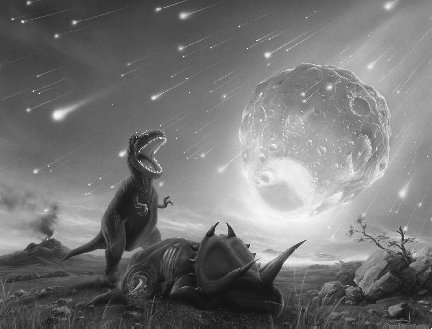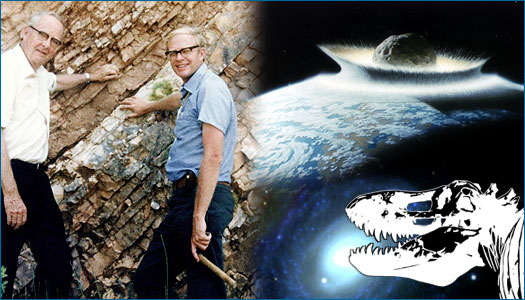|
DINOSAURS - WHY ARE THEY SUCH A BIG DEAL? Primarily because they were big - they were the largest and most successful land animals ever to live on the earth. Also, they enjoyed a remarkably long (over 150 million years) reign as the dominant fauna - a close look at their past history reveals that they were extremely successful animals.
WHAT DO DINOSAURS REPRESENT TO THE GENERAL PUBLIC? Children view dinosaurs with great fascination because they are "safe monsters" and because their scientific names are difficult to pronounce by their parents (which delights children greatly). Adults who are interested in dinosaurs probably had such an interest in their earlier childhood years. For the majority of the public, dinosaurs are the large, monstrous skeletons on display in museums representing untold eons ago. Yet, their conceptions of dinosaurs as a group have probably been colored by Hollywood monster movies, or by outdated dinosaur books aimed primarily at children. In the business world, the word "dinosaur" has come to represent "cumbersome obsolescence" (such as the old style, big, gas guzzling automobiles).
WHAT'S NEW WITH THE STUDY OF DINOSAURS? Plenty - over the last few decades, a "dinosaur renaissance" has been brought about by a new breed of paleontologists looking at field evidence from many disciplines. They are looking at new aspects of dinosaurs, such as their physiology, their lifestyles, their childhood years, and their ecological relationships with each other. Also being debated are previous assumptions of dinosaurs being cold-blooded (ectothermic) and sluggish as modern reptiles are, and the various extinction theories, which invoke some catastrophic cosmic events. Some paleontologists have suggested that dinosaurs were the forerunners of modern birds. The sheer volume of new dinosaur discoveries has increased, as many finds are being reported in China, and in the U.S. (Dinosaur National Monument in Jensen, Utah), Texas (theropod footprints) and Arizona. Extremely rare discoveries have included dinosaur juveniles, eggs, and very early ancestral forms. The new image of dinosaurs is best seen in the recent Hollywood cinema, such as the movie, Jurassic Park, which was made in consultation with Jack Horner and Bob Bakker, two of the leading dinosaur paleontologists of today.
IF DINOSAURS DID SO WELL, WHY DID THEY DIE OUT? The popular use of the word dinosaur implies
that they were "slow, lumbering, stupid beasts" who deserved to suffer
extinction as their fate before "superior mammals." Yet, scientific evidence
shows clearly that in direct competition with our mammalian ancestors,
the dinosaurs were the superior ones - they dominated the earth for twice
as long as the mammals, and were the most intelligent creatures of their
time. Yet the dinosaurs still became extinct, probably through no fault
of their own. The extinction of the dinosaurs
along with nearly one half of all species at the end of the Cretaceous
Period is one of the greatest scientific mysteries of all time. Since the
Alvarez theory was proposed in 1979, and much debated has ensued, most
scientists have come to accept the impact of a 6-mile
wide meteorite as the cause of the Cretaceous extinction; the leading
lines of evidence found at the Cretaceous-Tertiary
boundary include: shocked quartz crystals (stishovite,
a form produced only by very high-pressure impact), enrichment of iridium
(an element rare on earth, but common in meteorites), and widespread deposits
of soot (evidence of huge forest fires). The leading candidate
for the location of the impact crater is somewhere in the waters of the
Yucatan Peninsulan (near Chixulub) in the Gulf of Mexico, because there
is dramatic evidence of overturned late Cretaceous sediments caused by
a large impact in water. The debate over the details will still rage on
for years to come. The focus of dinosaur paleontologists is not "Why
did the dinosaurs become extinct?" but rather, "Why did they last for so
long?" Remember that mammals arose almost simultaneously with the reptiles,
yet lived in the shadow of the dinosaurs. Only the death of the dinosaurs
allowed mammals to fill the ecological vacuum. Some paleontologists believe
that were it not for some cosmic catastrophe, the dinosaurs would have
continued to evolve, and modern mammals (and man) may not have evolved
to their present form.
This
web page has been translated into the Czech language by Barbora Lebedova
Rewriting
the Book on Dinosaurs
Comparative
Size Diagram of the Largest Dinosaur Predators
Asteroids
and dinosaurs: Unexpected twists and an unfinished story
Walking
With Dinosaurs (YouTube)
|

